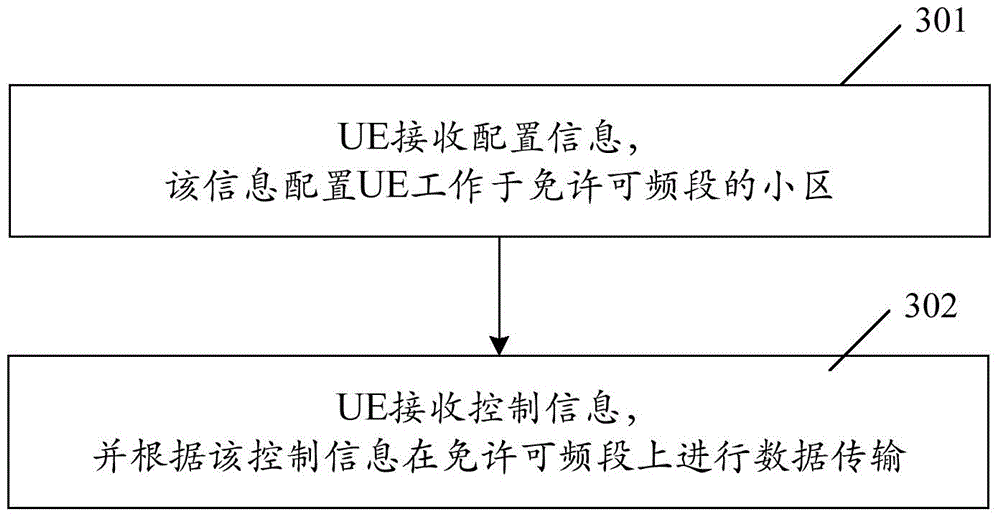Method and device for transmitting data on unlicensed frequency range
A technology of data transmission and frequency band, which is applied in the directions of digital transmission system, transmission system, and multiple use of transmission paths, which can solve the problems of uncertainty of interference level and difficulty in guaranteeing the quality of LTE transmission services.
- Summary
- Abstract
- Description
- Claims
- Application Information
AI Technical Summary
Problems solved by technology
Method used
Image
Examples
Embodiment 1
[0106] The 802.11 system works based on the carrier sense multiple access / collision avoidance (CSMA / CA) mechanism. A mobile station (STA) must detect the wireless channel before sending a signal. Only when the wireless channel is idle and remains for a certain period of time , the STA can occupy the wireless channel to send signals. Here, the STA may jointly use two sets of mechanisms to jointly determine the wireless channel state. On the one hand, STAs can use carrier sense technology to actually measure wireless channels. When detecting signals from other STAs or signal power exceeds a certain threshold, the STA considers the wireless channel to be busy; on the other hand, the 802.11 specification also introduces a virtual Carrier sensing technology, that is, Network Allocation Vector (NAV), contains a duration field in each 802.11 frame, and sets the value of NAV according to the duration field. NAV indicates the time when a wireless channel needs to be reserved, that is, ...
Embodiment 2
[0118] The 802.11 system works based on the CSMA / CA mechanism. A STA must detect the wireless channel before sending a signal, and only when the wireless channel is idle for a certain period of time, the STA can occupy the wireless channel to send signals. Such as Figure 6 Shown is a schematic diagram of the structure of the protocol data packet of the Physical Layer Convergence Protocol (PLCP) of WiFi. In chronological order, a physical layer transmission data packet is composed of PLCP preamble, PLCP header and WiFi data. in:
[0119] The PLCP preamble is used for timing synchronization, etc.
[0120] The PLCP header contains some control information for decoding WiFi data, in particular, it contains the encoding rate (RATE) and length (LENGTH). RATE indicates the transmission rate of the data part, and LENGTH indicates the number of bytes contained in the physical layer service data unit (PSDU). According to RATE and LENGTH, the time that WiFi data transmission needs to ...
Embodiment 3
[0126] On the unlicensed frequency band, the LTE-U system can work in a way of discontinuously occupying wireless channels. That is, the LTE-U system reserves a wireless channel for a period of time when there is a business demand, and calculates the length of time for which the wireless channel needs to be reserved according to the traffic demand, so that the LTE-U transmission during this time period can not be affected by WiFi ; After the reserved time expires, the LTE-U stops transmitting signals on the wireless channel until the next time the wireless channel is reserved. Here, when the wireless channel needs to be occupied, the LTE-U system can first detect the state of the wireless channel, and when the wireless channel is idle, use the method of embodiment 1 or embodiment 2 to reserve the wireless channel to prevent mutual interference with the WiFi system . Between two LTE-U reserved wireless channel operations, there may be a period of time not used for LTE-U transm...
PUM
 Login to View More
Login to View More Abstract
Description
Claims
Application Information
 Login to View More
Login to View More - R&D
- Intellectual Property
- Life Sciences
- Materials
- Tech Scout
- Unparalleled Data Quality
- Higher Quality Content
- 60% Fewer Hallucinations
Browse by: Latest US Patents, China's latest patents, Technical Efficacy Thesaurus, Application Domain, Technology Topic, Popular Technical Reports.
© 2025 PatSnap. All rights reserved.Legal|Privacy policy|Modern Slavery Act Transparency Statement|Sitemap|About US| Contact US: help@patsnap.com



